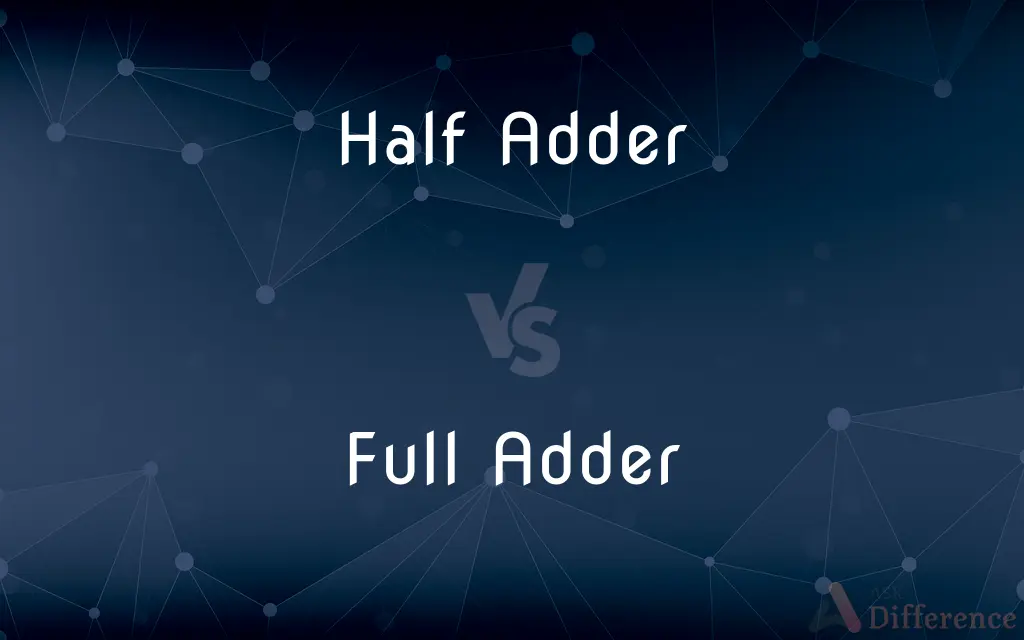Half Adder vs. Full Adder — What's the Difference?
Edited by Tayyaba Rehman — By Fiza Rafique — Published on January 7, 2024
Half Adder performs binary addition without carry input; Full Adder adds binary numbers including carry input.

Difference Between Half Adder and Full Adder
Table of Contents
ADVERTISEMENT
Key Differences
Half Adder adds two single bits. Full Adder adds three bits, considering carry.
Half Adder outputs sum and carry. Full Adder, more complex, handles carry from previous addition.
Half Adder is simpler, used in basic circuits. Full Adder is fundamental in arithmetic circuits.
Half Adder can't add consecutive bits. Full Adder adds sequential binary numbers with carry.
Both Half Adder and Full Adder perform binary addition, but Full Adder is more versatile.
ADVERTISEMENT
Comparison Chart
Input Bits
2 bits (A and B)
3 bits (A, B, and Carry-in)
Carry Input
No carry input
Includes carry input
Complexity
Simpler design
More complex design
Usage
Basic addition tasks
Sequential binary addition
Functionality
Limited to single-bit addition
Adds consecutive bits with carry
Compare with Definitions
Half Adder
Consists of an XOR and AND gate.
The XOR and AND gates in the Half Adder perform binary addition.
Full Adder
A circuit adding three binary bits.
The Full Adder handles more complex binary operations than a Half Adder.
Half Adder
A logic circuit that adds two bits.
The Half Adder in the calculator simplifies binary addition.
Full Adder
More versatile than a Half Adder.
The Full Adder's design offers greater functionality in digital systems.
Half Adder
Basic digital arithmetic tool.
Engineers use a Half Adder for simple digital designs.
Full Adder
Includes carry-in functionality.
The Full Adder's carry-in feature allows for sequential addition.
Half Adder
Outputs sum and carry.
The Half Adder's carry output is crucial for basic binary arithmetic.
Full Adder
Essential in arithmetic circuits.
Computers use Full Adders for efficient binary calculations.
Half Adder
No carry-in feature.
The lack of carry-in makes the Half Adder unsuitable for complex calculations.
Full Adder
Combines two Half Adders and an OR gate.
The structure of a Full Adder allows it to handle binary addition with carry.
Common Curiosities
Is a Full Adder more complex than a Half Adder?
Yes, a Full Adder is more complex as it handles additional carry input.
What are the main components of a Half Adder?
The main components of a Half Adder are an XOR gate and an AND gate.
What is the primary use of a Full Adder?
The primary use of a Full Adder is in sequential binary addition and arithmetic circuits.
Do Full Adders have limitations?
While versatile, Full Adders have speed and complexity limitations in large-scale operations.
What is a Half Adder?
A Half Adder is a circuit that adds two single binary digits and outputs the sum and carry.
What is a Full Adder?
A Full Adder is a circuit that adds three binary digits, including carry, and outputs the sum and carry.
Can Full Adders be cascaded?
Yes, Full Adders can be cascaded for adding multi-bit binary numbers.
Is a Half Adder sufficient for a calculator?
A Half Adder alone is not sufficient; calculators use Full Adders for comprehensive binary operations.
Can a Half Adder handle carry input?
No, a Half Adder cannot handle carry input.
How does carry work in a Half Adder?
In a Half Adder, the carry is the output from the AND gate, indicating if both inputs are 1.
How do Full Adders contribute to CPU function?
Full Adders are integral in the arithmetic logic units (ALUs) of CPUs for performing binary operations.
Can two Half Adders make a Full Adder?
Yes, two Half Adders combined with an OR gate can function as a Full Adder.
Are Half Adders used in modern computers?
Half Adders are fundamental but are part of more complex systems like Full Adders in modern computers.
Are Half and Full Adders energy-efficient?
Their energy efficiency depends on the design and technology used in constructing them.
Can a Full Adder add decimal numbers?
No, Full Adders are designed specifically for binary numbers.
Share Your Discovery

Previous Comparison
Fox Terrier vs. Jack Russell
Next Comparison
Bubble Sort vs. Insertion SortAuthor Spotlight
Written by
Fiza RafiqueFiza Rafique is a skilled content writer at AskDifference.com, where she meticulously refines and enhances written pieces. Drawing from her vast editorial expertise, Fiza ensures clarity, accuracy, and precision in every article. Passionate about language, she continually seeks to elevate the quality of content for readers worldwide.
Edited by
Tayyaba RehmanTayyaba Rehman is a distinguished writer, currently serving as a primary contributor to askdifference.com. As a researcher in semantics and etymology, Tayyaba's passion for the complexity of languages and their distinctions has found a perfect home on the platform. Tayyaba delves into the intricacies of language, distinguishing between commonly confused words and phrases, thereby providing clarity for readers worldwide.
















































